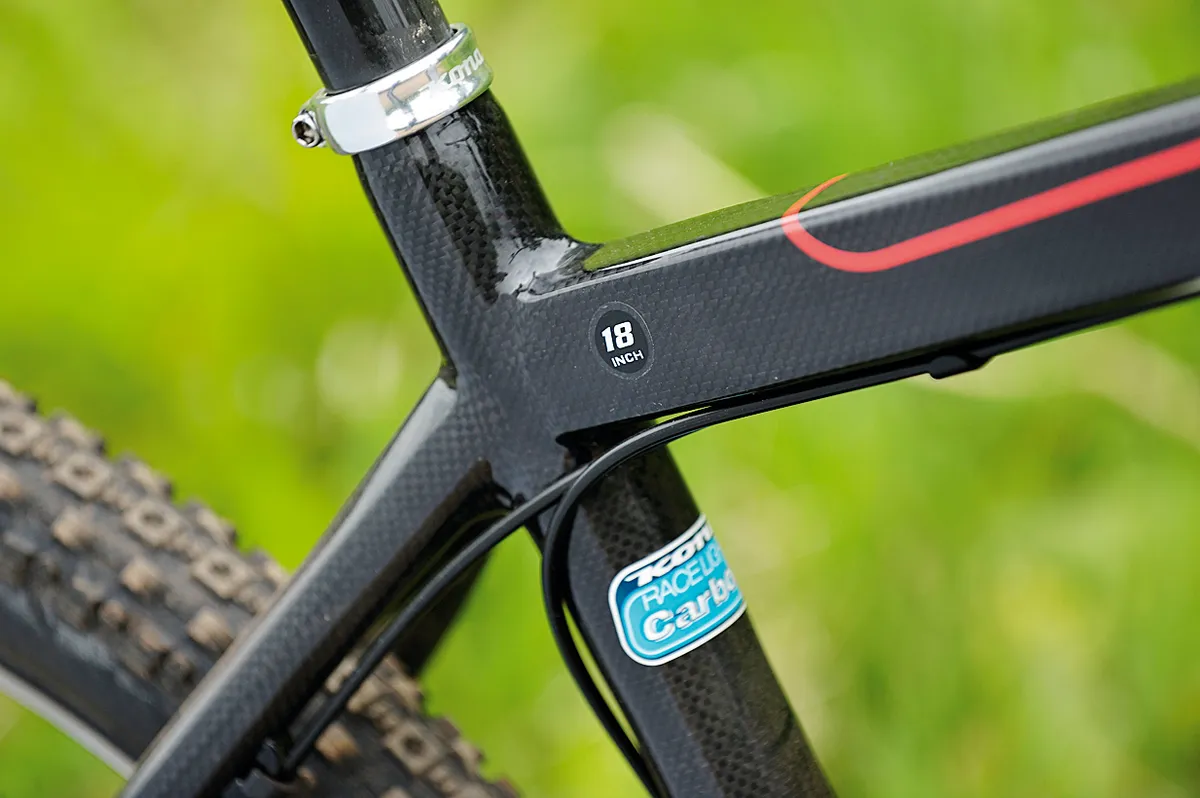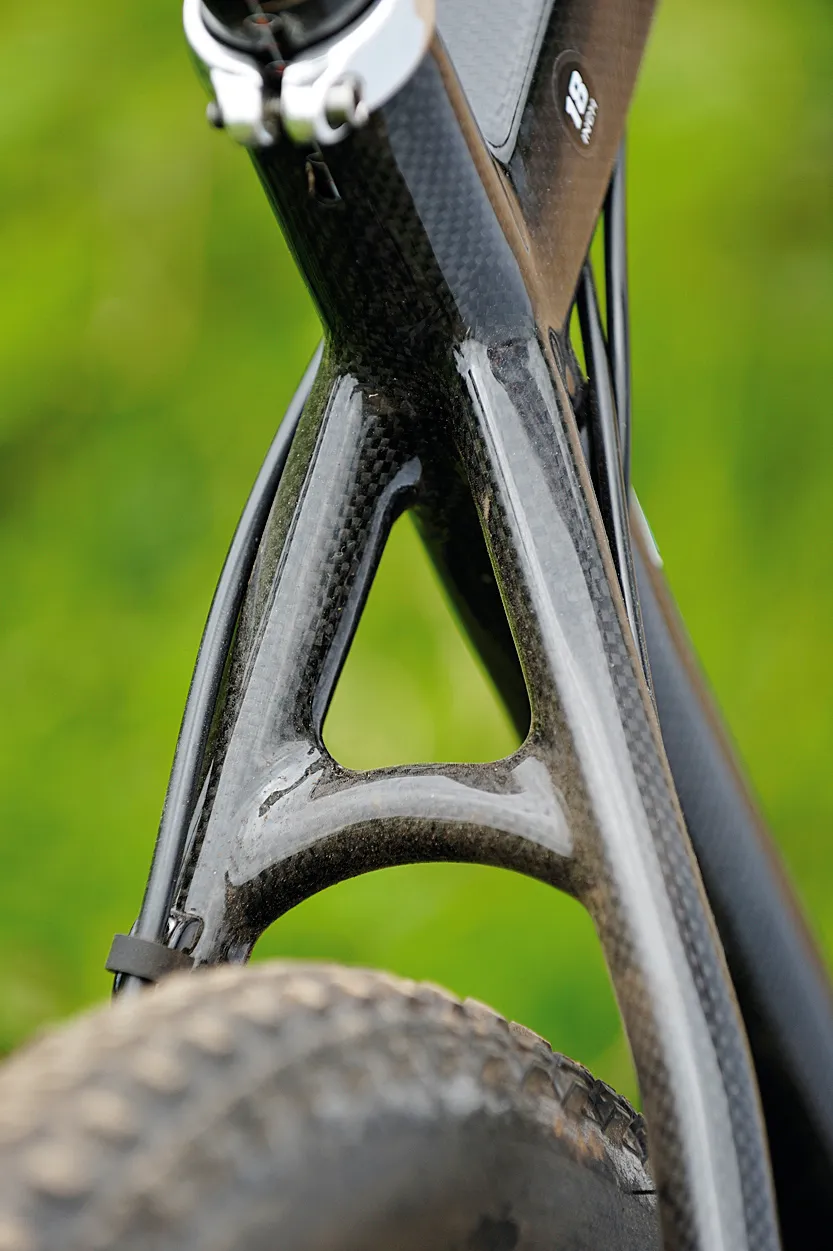It was only a matter of time before Kona committed to carbon. With old-school steel Kilaueas gaining in value as the retro market strengthens, this seems as good a time as any to make a featherweight carbon version for cross-country racers, or anyone else who fancies blatting around trails on a 20lb rig.
The low weight of the Kilauea takes a short while to get used to. It takes handling finesse and confidence to maintain the advantage you’ve gained on climbs as you skim down the drops. But as confidence grows, and it does quickly because of the relatively relaxed steering geometry, you’ll increasingly revel in the easy acceleration and sprightly handling. In the right hands, it’s a race winning bike; in the wrong hands, a fidgety stallion.
Ride & handling: A racer by design that has trail riding in its veins
The vast majority of the mountain bikes we test weigh between 25lb and 30lb, so it always feels odd climbing on a 20lb bike. As with other carbon flyweights, the Kilauea initially feels fragile and nervous on rough terrain. The wheels skip and ping off hard edges, pedal responses are instant, steering is really light and it takes a while to relax, gain handling confidence, stop covering the brakes and just go with the speed that comes so easily.
Within a few off-road miles of setting off you’ve almost forgotten you’re riding such a light and lively machine though, and from that point you progressively start learning how to get the best out of it. It’s the acceleration and climbing prowess of the Kilauea that sets it apart from heavier, and cheaper, race-tuned hardtails.
Push the pedals and your speed surges without exerting brute force, which you should save for the climbs because ascending on a 20lb bike is simply inspiring. Don’t be tempted to fit skinny tyres though; they’ll exaggerate the nervous handling whereas bigger treads with a fast knob profile (like the 2.1in Maxxis CrossMarks fitted) help to tame all the little bumps that might otherwise flick you off line.
Because the geometry of the Kilauea is a little more relaxed than most pure race bikes, it encourages you to ride rough trails with a much more carefree attitude: the 26.5in low rise bar fitted to the test bike was a good choice for the same reason. The vibration damping character of the frame also encourages you to really pile on the pressure across bumpy terrain.
You’ll soon find yourself floating over the saddle as you power-skip over the tops of the bumps rather than dip into the gaps in between. You need to be aware of the low bottom bracket though: we clipped the pedals on rocks a few times as the fork compressed while pedalling through bends. But the plus side of a low bottom bracket is extra stability; we really welcomed that as we charged through speedier bits of trail.

A lot of people ask us about the feel differences between lightweight aluminium and lightweight carbon frames. It’s hard to generalise, because they’re not all created equal, but as a rule (and we certainly noticed this here) the ride of a lightweight carbon frame feels slightly softer over bumpy terrain because of the carbon structure’s ability to absorb vibration.
This actually makes a 20lb carbon framed bike like the Kilauea slightly easier to ride than a 20lb aluminium framed bike. Both can feel a little flighty at times, especially if you’re not used to lightweight bikes, but with a carbon bar and seatpost fitted to the Kilauea you’ll notice the extra comfort compared to an alu framed bike with an alu post and handlebar.
Frame & equipment: Classy, super-light chassis plus pimpy top-end kit
Kitted out with Shimano XTR brakes and drivetrain, Mavic Crossmax SLR wheelset and pimpy top-end Ritchey finishing kit, our 20.4lb (9.25kg) test bike would cost you around £3,750. It’s a really classy looking frame – shiny black from a distance, with the carbon weave showing through the thick lacquer when you get close.
The tube forms are purely functional but aesthetically appealing, with Kona’s usual sloped top tube and extended seat tube, loads of mud room between the rear stays and two sets of bottle cage bosses. The rear gear has outer cable all the way and the rear stays have a brace tube to stop the disc brake vibrating through the frame structure.
We found it a little disappointing that Kona couldn’t offer us much detailed technical information on the frame. We have no particular reason to doubt their claim of “state-of-the-art construction techniques” and we’re happy to confirm the good “balance between stiffness, light weight and ride quality” claim.
However, the “unique tube-to-tube structure with monocoque process” and “perfect balance of force flow throughout the entire structure of the frame” sound like the marketing spiel of countless other Far-Eastern-built carbon composite structures. Apparently we’ll see a little more carbon fibre being used in Kona’s high-end hardtails for 2011, and on other platforms in future years.
The Kilauea is designed to take a short-travel fork and our test bike came with Fox’s F-Series RLC with 80mm of travel – but it will happily accept a 100mm suspension fork too. An 80mm fork produces a static geometry of 69.5 degrees at the head and 71.5 at the seat. It’s slightly slacker than many cross-country race bikes but well suited to the sort of casual high-speed trail riding that thrills, although there will be times when you’ll wish the bottom bracket was higher than 12in.


